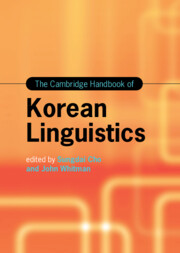Book contents
- The Cambridge Handbook of Korean Linguistics
- Cambridge Handbooks in Language and Linguistics
- The Cambridge Handbook of Korean Linguistics
- Copyright page
- Contents
- Figures
- Tables
- Contributors
- Preface
- Acknowledgments
- Abbreviations
- Part I Korean Overview
- Part II Phonetics and Phonology
- Chapter 7 Vowel Harmony
- Chapter 8 The Phonology and Phonetics of Korean Stop Laryngeal Contrasts
- Chapter 9 The Phonetics-Prosody Interface and Prosodic Strengthening in Korean
- Chapter 10 Constituent Structure and Sentence Phonology of Korean
- Chapter 11 Effects of Linguistic Experience on the Perception of Korean Stops
- Part III Morphology and Syntax
- Part IV Semantics and Pragmatics
- Part V Sociolinguistics and Psycholinguistics
- Part VI Language Pedagogy
- Index
- References
Chapter 11 - Effects of Linguistic Experience on the Perception of Korean Stops
from Part II - Phonetics and Phonology
Published online by Cambridge University Press: 30 September 2022
- The Cambridge Handbook of Korean Linguistics
- Cambridge Handbooks in Language and Linguistics
- The Cambridge Handbook of Korean Linguistics
- Copyright page
- Contents
- Figures
- Tables
- Contributors
- Preface
- Acknowledgments
- Abbreviations
- Part I Korean Overview
- Part II Phonetics and Phonology
- Chapter 7 Vowel Harmony
- Chapter 8 The Phonology and Phonetics of Korean Stop Laryngeal Contrasts
- Chapter 9 The Phonetics-Prosody Interface and Prosodic Strengthening in Korean
- Chapter 10 Constituent Structure and Sentence Phonology of Korean
- Chapter 11 Effects of Linguistic Experience on the Perception of Korean Stops
- Part III Morphology and Syntax
- Part IV Semantics and Pragmatics
- Part V Sociolinguistics and Psycholinguistics
- Part VI Language Pedagogy
- Index
- References
Summary
Chapter 11 shows how linguistic experience plays a vital role in the perception and production of L2 speech sounds. The study presented in this chapter examines the differences between advanced English-speaking heritage language (HL) and non-heritage language (non-HL) learners of Korean by looking at their cross-linguistic categorization patterns and their degree of accuracy in identifying Korean stops. As predicted, based on the SLM, HL learners’ performance was more similar to the Korean native speakers than was non-HL learners’ performance. The results suggest that early exposure to the HL does indeed give an advantage to HL learners over their advanced non-HL counterparts, and that longer exposure to the target language for non-HL learners has a positive but limited role in obtaining a native-like perception of the three-way contrasts in Korean stops.
Keywords
- Type
- Chapter
- Information
- The Cambridge Handbook of Korean Linguistics , pp. 318 - 336Publisher: Cambridge University PressPrint publication year: 2022

